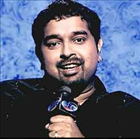
‘A singer with fire in his voice’- that’s how Tabla maestro Zakir Hussain had once described Sankar Mahadevan to me; but that is not the only thing he does well. As a trained classical musician, a popular playback singer, a fusion exponent and the member of the leading Bollywood composer trio- Shankar- Ehsan- Loy - he is a man wearing many hats.
As the interview begins, I set the ball rolling by asking Shankar about the eclectic musical roots of his music and how he manages to effortlessly switch different genres. After a thoughtful pause, he replies, “I feel my musical foundation is very strong, thanks to the Carnatic classical training I received from my Guru T. R. Bala Mani. But it wasn’t enough for me to stay just within those realms and so I kept on exploring other musical horizons like Hindustani classical music, fusion music, pop music and film music.”
Breathless
Then I ask him about Breathless- the pop album that practically announced his arrival to the world. When I comment that it was a complete musical package rather than just one popular song followed by some meaningless fillers, he is happy. He says, “Thanks for noticing that. Breathless was an honest album straight from the heart. I was working with a master lyricist like Javed Akhtar and we just created songs that appealed to our sensitivity, without really bothering about the trends in the market.”
“But till then you had remained out of the limelight.” This observation from me prompts him to introspect and he says, “Whether we like it or not in India, the barometer of musical success remains film music. The weird thing about this country is that they associate a voice with a face. For them it is not Sonu Nigam singing the song Ka Ho Na Ho, they think it is Shahrukh Khan himself. So until that face and voice association doesn’t happen, the singer often remains in the shadows. Before Breathless, I was doing a lot of successful television jingles and had sung hit film songs like Ooh Lalala and Urvasi but still no one knew me well. Breathless- video gave people that association between face and voice.”


